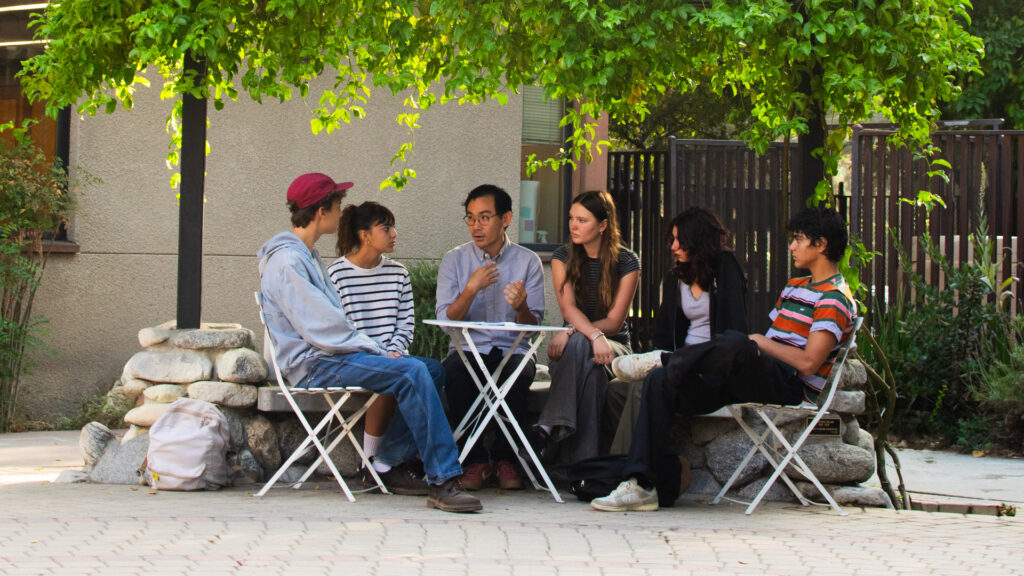
Sequoyah Community
Centering Belonging
A proud alum, RJ Sakai ‘04 served as the high school’s Director of Social Innovation until 2024, when he was selected to oversee Diversity, Equity, Inclusion, and Justice (DEIJ) at Sequoyah. RJ has worked to lead DEIJ coalition efforts at both campuses, expand the school’s understanding of diversity, and center the voices of students and families most impacted by inequities through his work with the affinity conveners.
As we begin the 2025-26 school year, Phoenix spoke with RJ about the progress he’s made—and what we can look forward to seeing in the months to come.
What makes DEIJ unique at Sequoyah?
Since our founding, we’ve seen diversity not just as a morally imperative add-on, but as an ingredient that is essential to shaping young people who will thrive in all of their future relationships and communities. I’m proud to be part of an institution that understands effective DEIJ work not solely as the more visible and necessary monthly celebrations of heritage and culture, but also as an essential lens that enhances more behind-the-scenes endeavors such as board-led strategic planning, institutional systems like hiring practices, capacity building and training for teachers and staff, and school-wide policies around community repair after harm occurs.
Importantly, we also hold ourselves accountable by tracking how well we are serving students and families from historically marginalized backgrounds, and by addressing barriers that limit full access to belonging. At Sequoyah School, we find purpose in both the delights of participating in a diverse community, as well as the productive challenges.
What are some things you’re excited about for this coming year?
So many to name! First, I’m proud of the work we’re continuing from last year around constructive dialogue. Over the summer, staff chose one of three books to read related to building bridges across differences of opinion and identity: I Never Thought of It That Way by Mónica Guzman, Calling In by Loretta Ross, and The Power of Bridging by john a. powell. This year, teachers are infusing their lessons and classroom routines with learnings from these books to equip students of all ages with healthy strategies for engaging across difference, including honest conversations about race, bias, and inequity.
Second, I’m continually moved by the dedication of our affinity conveners—student, parent, and staff volunteers who create space for peers to gather, celebrate, and support each other throughout the year. This year, we’ll be collaborating with educator and trainer Rosetta Eun Ryong Lee to strengthen our affinity program.
Last, I’m grateful to my fellow members of the Board’s Strategic Planning Committee for so intuitively considering the lenses of diversity, equity, inclusion, and justice in the writing of our latest Strategic Plan, which will steer Sequoyah’s direction of our school in the years to come. I’m looking forward to putting that plan into action throughout this year.
What does an average week look like for you?
Of course, there is no average week when you work in a school! If you were to look at my calendar, you’d see a mix of meetings—co-facilitating Equity Alliance Stewardship Committee meetings with our high school student leaders; coaching a teacher one-on-one who is preparing to introduce a new unit on race with our youngest students; discussing long-term strategy with our DEIJ Board Committee; saying hi to our K-8 Neurodivergent Student Alliance lunchtime meeting; facilitating a professional development workshop for high school faculty on how to interrupt bias; or meeting with families of color to hear directly about their experiences.
My weeks are made very dynamic given the wide diversity of people I get to work with.
How can people get involved?
Our success relies on the participation of all community members. I’m eager to connect with past, present, and future community members who are interested in: becoming affinity conveners; sharing their family history or culture with our students; hosting field trips that take students’ learning out of the classroom; communicating the value of a Sequoyah education to prospective families; providing feedback about their experience at Sequoyah, and more.
Additionally, I welcome any other questions or ideas you might have. I look forward to connecting with you!
